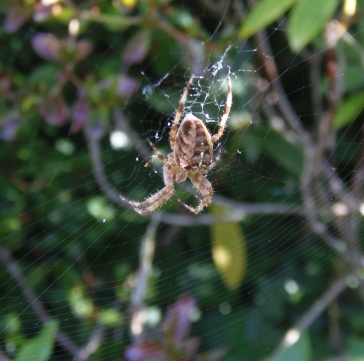
If you live in Europe or North America, chances are you have seen the species I have studied in my most recent paper at least once. The cross spider (Araneus diadematus) makes big beautiful orb webs, can easily be recognized by a cross-shaped white drawing on its abdomen, and you can find it pretty much anywhere. Really: in Europe, it is nearly always one of the dominant species (among the orb web-building group) both outside and inside cities. You can find other species that are as successful as the cross spider in natural habitats or in urban habitats, but it is the only one able to do very well in both. So what’s its secret?
In a previous study, we* placed glue traps outside and found that there are no difference in flying insects numbers between urban and non-urban habitats. However, these insects were much smaller in cities, which mean less food for our spiders. And contrary to raccoons, mice, sparrows… or even ants, spiders can’t exactly feed on our food waste to compensate. So they have to either find a way to adapt, or disappear from cities.
By analyzing the webs of 621 cross spiders in 63 sites in Belgium, we’ve been able to show that urban spiders do build different webs than rural spiders. In response to local-scale urbanization (a few tens to hundreds meters around spiders), they tend to build webs with narrower mesh. When the entire landscape around them (up to a few kilometers) becomes urbanized, spiders invest more silk in hunting, building webs that are on average 25% larger. Building a web with a narrower mesh means you are more likely to keep prey trapped until they’re killed (and you may have a slightly higher chance to catch small prey). And of course, the bigger your web, the more likely it is to intercept prey in the first place.
So we have changes in behavior that nicely compensate for the loss of food in cities, but is it actually evolution? Have spiders making better webs actually been selected? Couldn’t spiders have simply detected that prey were of lower quality and changed their building behavior?
Well, we don’t have a clear-cut proof yet, but there are hints of evolutionary change in the way spider response change depending on the scale of urbanization. I’m generalizing here, but a change that only occurs in response to localized urbanization (like the mesh width change) is less likely to be evolution, because non-adapted spiders from nearby habitats are permanently immigrating in, cancelling out any ongoing adaptation. Changes that are only seen in response to large-scale urbanization, like web size, are by contrast much more likely to result from evolutionary change.
It does not mean city life is perfect for spiders, though. There definitely are costs to living among humans: urban spiders make fewer eggs and are slightly smaller, maybe because of pollution and probably because even after all these web modifications, there is still not enough food in cities to sustain “rural-level big” spiders. But these negative effects are only seen in response to local-scale urbanization (so spiders in urban parks for instance are not affected) and population densities are the same in and outside cities, so it looks like they are doing fine, at least for now.

And we still have a lot to learn about urban ecology and evolution from the cross spider: colleagues in Belgium are now using it in a citizen science project to monitor insect populations (using webs) and the consequences of the Urban Heat Island effect (through changes in spider color).
Check out the full manuscript:
Urbanization-driven changes in web-building are decoupled from body size in an orb-web spider. Maxime Dahirel, Maarten De Cock, Pieter Vantieghem, Dries Bonte. Journal of Animal Ecology, DOI: 10.1111/1365-2656.12909
*I am using “we” very loosely here: on these spider projects, all the fieldwork was done by the other authors and I “merely” analyzed the data. If you want to see an urban ecology project in which I actually did fieldwork, you can see one here.
- City Snails Wear Yellow: Urban Heat Island Drives the Evolution of Shell Colour - September 24, 2019
- City Trails of Urban Snails - November 26, 2018
- Friendly Neighborhood Spiders - October 12, 2018

Leave a Reply